2018 NISSAN VERSA clutch
[x] Cancel search: clutchPage 17 of 354
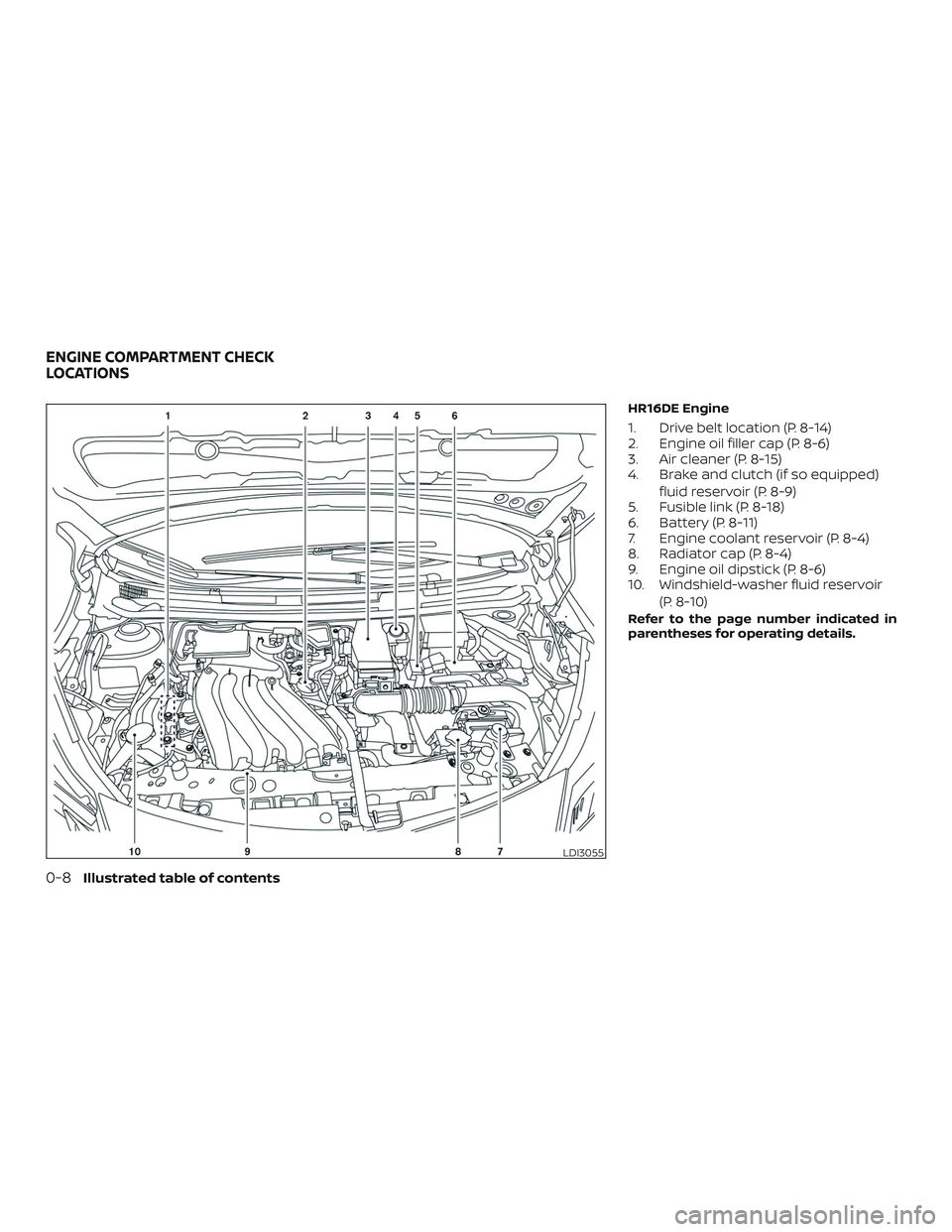
HR16DE Engine
1. Drive belt location (P. 8-14)
2. Engine oil filler cap (P. 8-6)
3. Air cleaner (P. 8-15)
4. Brake and clutch (if so equipped)
fluid reservoir (P. 8-9)
5. Fusible link (P. 8-18)
6. Battery (P. 8-11)
7. Engine coolant reservoir (P. 8-4)
8. Radiator cap (P. 8-4)
9. Engine oil dipstick (P. 8-6)
10. Windshield-washer fluid reservoir
(P. 8-10)
Refer to the page number indicated in
parentheses for operating details.
LDI3055
ENGINE COMPARTMENT CHECK
LOCATIONS
0-8Illustrated table of contents
Page 221 of 354

∙ Make sure the area around the vehicle is
clear.
∙ Check fluid levels such as engine oil,
coolant, brake and clutch fluid (if so
equipped), and windshield-washer fluid
as frequently as possible, or at least
whenever you refuel.
∙ Check that all windows and lights are
clean.
∙ Visually inspect tires for their appear-
ance and condition. Also check tires for
proper inflation.
∙ Lock all doors.
∙ Position seat and adjust head
restraints/headrests.
∙ Adjust inside and outside mirrors.
∙ Fasten seat belts and ask all passen-
gers to do likewise.
∙ Check the operation of warning lights
when the ignition switch is placed in the
ON position. For additional information,
refer to “Warning lights, indicator lights
and audible reminders” in the “Instru-
ments and controls” section of this
manual.1. Apply the parking brake.
2.Continuously Variable Transmission
models:
Move the shif t lever to P (Park) or N
(Neutral). P (Park) is recommended.
The shif t lever cannot be moved out
of P (Park) and into any of the other
gear positions if the ignition key is
turned to the OFF position or if the
key is removed from the ignition
switch.
The starter is designed not to oper-
ate if the shif t lever is in any of the
driving positions.
Manual transmission (M/T) models:
For best practice when operating an
M/T, depressing the clutch before
moving the shif t lever is ideal.
Move the shif t lever to N (Neutral). De-
press the clutch pedal to the floor
while cranking the engine.
The starter is designed not to oper-
ate unless the clutch pedal is fully
depressed.3. Crank the enginewith your foot off
the accelerator pedalby turning the
ignition key to the START position. Re-
lease the key when the engine starts. If
the engine starts, but fails to run, repeat
the above procedure.
∙ If the engine is very hard to start in
extremely cold weather or when re-
starting, depress the accelerator
pedal a little (approximately 1/3 to the
floor) and hold it and then crank the
engine. Release the key and the ac-
celerator pedal when the engine
starts.
∙ If the engine is very hard to start be-
cause it is flooded, depress the accel-
erator pedal all the way to the floor
and hold it. Crank the engine for
5-6 seconds. Af ter cranking the en-
gine, release the accelerator pedal.
Crank the enginewith your foot off
the accelerator pedalby turning the
ignition key to the START position. Re-
lease the key when the engine starts.
If the engine starts, but fails to run,
repeat the above procedure.
BEFORE STARTING THE ENGINE STARTING THE ENGINE
5-10Starting and driving
Page 227 of 354
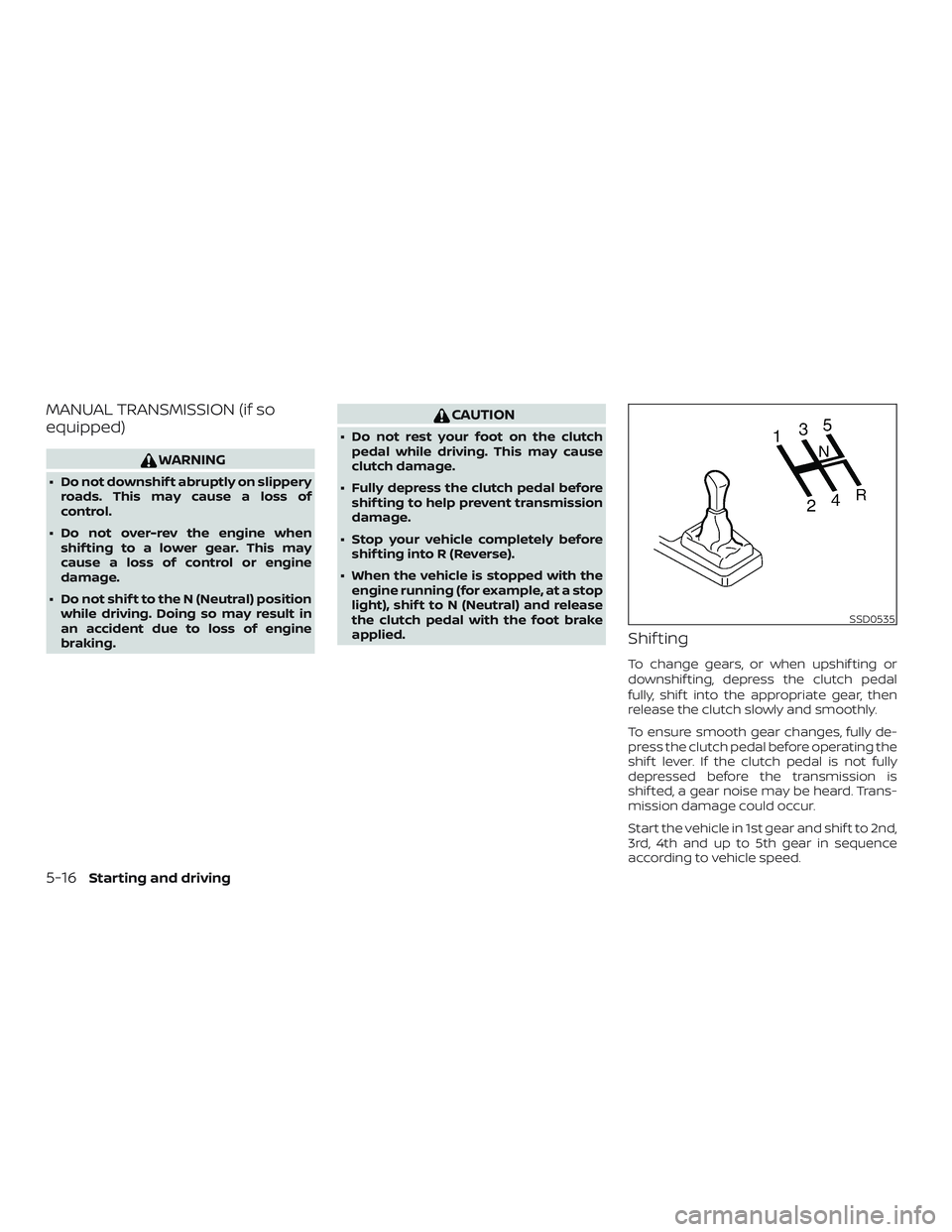
MANUAL TRANSMISSION (if so
equipped)
WARNING
∙ Do not downshif t abruptly on slippery
roads. This may cause a loss of
control.
∙ Do not over-rev the engine when
shif ting to a lower gear. This may
cause a loss of control or engine
damage.
∙ Do not shif t to the N (Neutral) position
while driving. Doing so may result in
an accident due to loss of engine
braking.
CAUTION
∙ Do not rest your foot on the clutch
pedal while driving. This may cause
clutch damage.
∙ Fully depress the clutch pedal before
shif ting to help prevent transmission
damage.
∙ Stop your vehicle completely before
shif ting into R (Reverse).
∙ When the vehicle is stopped with the
engine running (for example, at a stop
light), shif t to N (Neutral) and release
the clutch pedal with the foot brake
applied.
Shif ting
To change gears, or when upshif ting or
downshif ting, depress the clutch pedal
fully, shif t into the appropriate gear, then
release the clutch slowly and smoothly.
To ensure smooth gear changes, fully de-
press the clutch pedal before operating the
shif t lever. If the clutch pedal is not fully
depressed before the transmission is
shif ted, a gear noise may be heard. Trans-
mission damage could occur.
Start the vehicle in 1st gear and shif t to 2nd,
3rd, 4th and up to 5th gear in sequence
according to vehicle speed.
SSD0535
5-16Starting and driving
Page 228 of 354
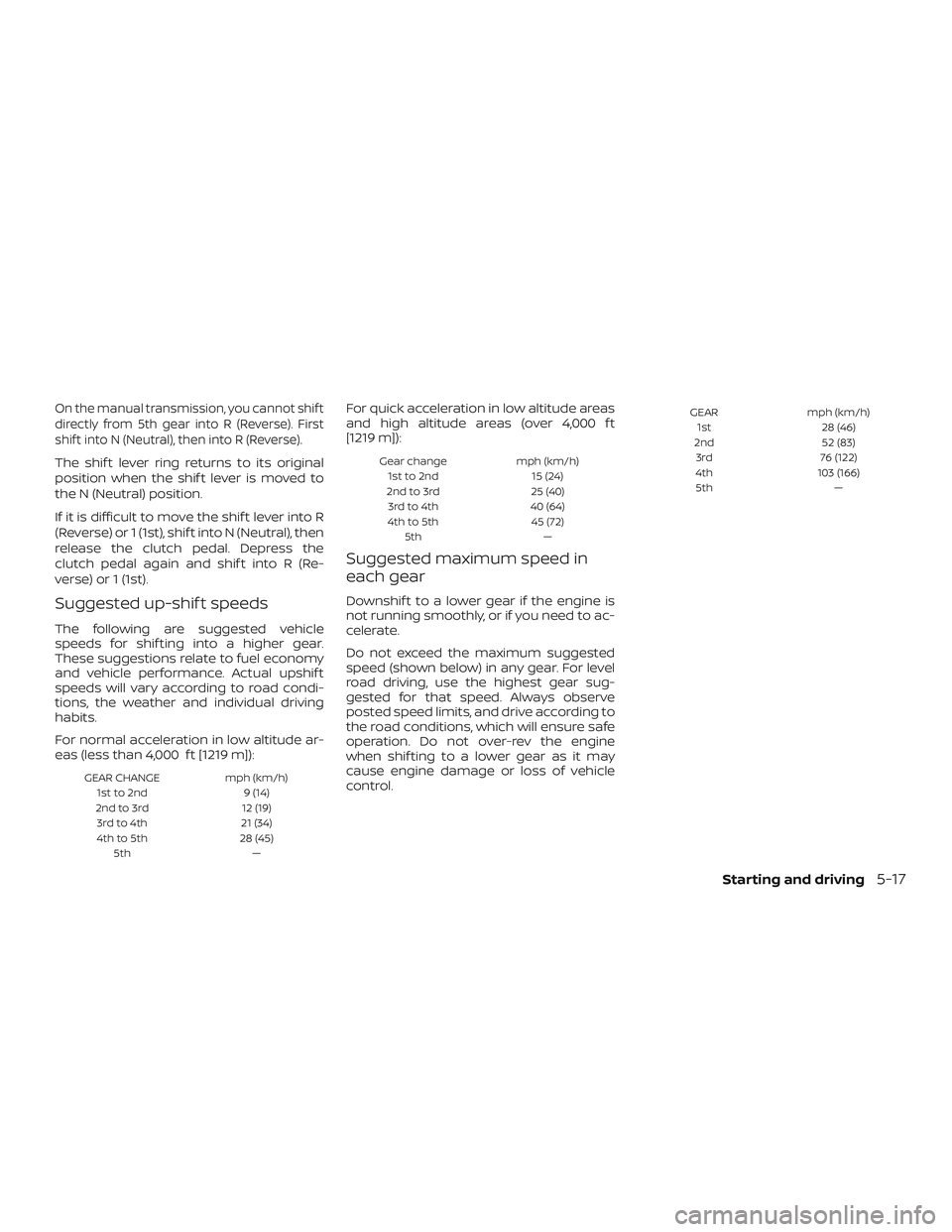
On the manual transmission, you cannot shif t
directly from 5th gear into R (Reverse). First
shif t into N (Neutral), then into R (Reverse).
The shif t lever ring returns to its original
position when the shif t lever is moved to
the N (Neutral) position.
If it is difficult to move the shif t lever into R
(Reverse) or 1 (1st), shif t into N (Neutral), then
release the clutch pedal. Depress the
clutch pedal again and shif t into R (Re-
verse) or 1 (1st).
Suggested up-shif t speeds
The following are suggested vehicle
speeds for shif ting into a higher gear.
These suggestions relate to fuel economy
and vehicle performance. Actual upshif t
speeds will vary according to road condi-
tions, the weather and individual driving
habits.
For normal acceleration in low altitude ar-
eas (less than 4,000 f t [1219 m]):
GEAR CHANGE mph (km/h)
1st to 2nd 9 (14)
2nd to 3rd 12 (19)
3rd to 4th 21 (34)
4th to 5th 28 (45)
5th —
For quick acceleration in low altitude areas
and high altitude areas (over 4,000 f t
[1219 m]):
Gear change mph (km/h)
1st to 2nd 15 (24)
2nd to 3rd 25 (40)
3rd to 4th 40 (64)
4th to 5th 45 (72)
5th —
Suggested maximum speed in
each gear
Downshif t to a lower gear if the engine is
not running smoothly, or if you need to ac-
celerate.
Do not exceed the maximum suggested
speed (shown below) in any gear. For level
road driving, use the highest gear sug-
gested for that speed. Always observe
posted speed limits, and drive according to
the road conditions, which will ensure safe
operation. Do not over-rev the engine
when shif ting to a lower gear as it may
cause engine damage or loss of vehicle
control.
GEAR mph (km/h)
1st 28 (46)
2nd 52 (83)
3rd 76 (122)
4th 103 (166)
5th —
Starting and driving5-17
Page 230 of 354
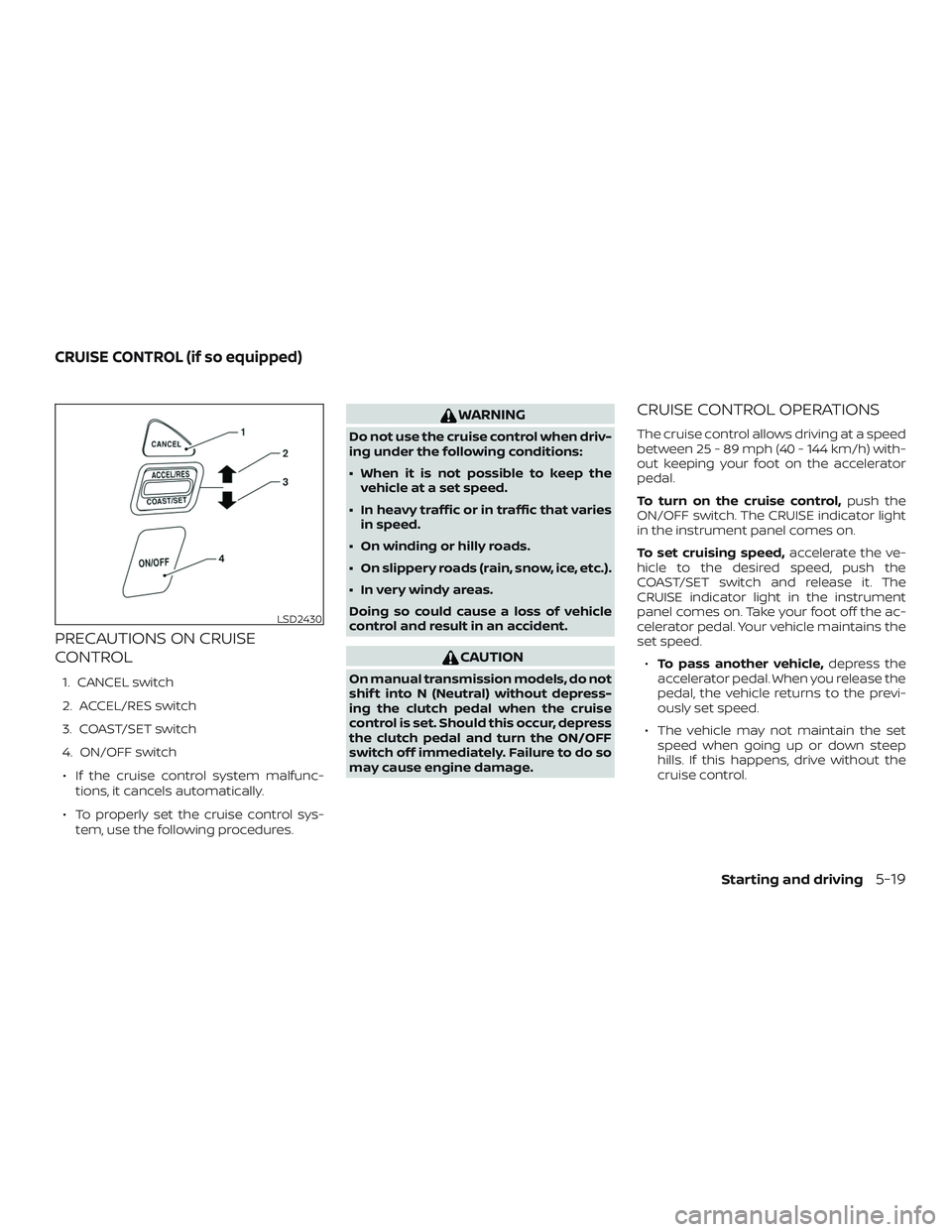
PRECAUTIONS ON CRUISE
CONTROL
1. CANCEL switch
2. ACCEL/RES switch
3. COAST/SET switch
4. ON/OFF switch
∙ If the cruise control system malfunc-
tions, it cancels automatically.
∙ To properly set the cruise control sys-
tem, use the following procedures.
WARNING
Do not use the cruise control when driv-
ing under the following conditions:
∙ When it is not possible to keep the
vehicle at a set speed.
∙ In heavy traffic or in traffic that varies
in speed.
∙ On winding or hilly roads.
∙ On slippery roads (rain, snow, ice, etc.).
∙ In very windy areas.
Doing so could cause a loss of vehicle
control and result in an accident.
CAUTION
On manual transmission models, do not
shif t into N (Neutral) without depress-
ing the clutch pedal when the cruise
control is set. Should this occur, depress
the clutch pedal and turn the ON/OFF
switch off immediately. Failure to do so
may cause engine damage.
CRUISE CONTROL OPERATIONS
The cruise control allows driving at a speed
between 25 - 89 mph (40 - 144 km/h) with-
out keeping your foot on the accelerator
pedal.
To turn on the cruise control,push the
ON/OFF switch. The CRUISE indicator light
in the instrument panel comes on.
To set cruising speed,accelerate the ve-
hicle to the desired speed, push the
COAST/SET switch and release it. The
CRUISE indicator light in the instrument
panel comes on. Take your foot off the ac-
celerator pedal. Your vehicle maintains the
set speed.
∙To pass another vehicle,depress the
accelerator pedal. When you release the
pedal, the vehicle returns to the previ-
ously set speed.
∙ The vehicle may not maintain the set
speed when going up or down steep
hills. If this happens, drive without the
cruise control.
LSD2430
CRUISE CONTROL (if so equipped)
Starting and driving5-19
Page 231 of 354

To cancel the preset speed,use one of the
following three methods:
∙ Push the CANCEL switch; the CRUISE
indicator light in the instrument panel
goes out.
∙ Tap the brake pedal; the CRUISE indica-
tor light goes out.
∙ Push the ON/OFF switch off. The CRUISE
indicator light in the instrument panel
goes out.
The cruise control is automatically can-
celed and the CRUISE indicator light in the
instrument panel goes out if:
∙ You depress the brake or clutch pedal
while pushing the ACCEL/RES or
SET/COAST switch. The preset speed is
deleted from memory.
∙ The vehicle slows down more than
8 mph (13 km/h) below the set speed.
∙ You depress the clutch pedal (manual
transmission), or move the shif t lever
into N (Neutral) (Continuously Variable
Transmission).
To reset at a faster cruising speed,use
one of the following three methods:
∙
Depress the accelerator pedal. When the
vehicle attains the desired speed, push
and release the COAST/SET switch.
∙ Push and hold the ACCEL/RES switch.
When the vehicle attains the speed you
desire, release the switch.
∙ Push and release the ACCEL/RES
switch. Each time you do this, the set
speed increases by about 1 mph
(1.6 km/h).
To reset at a slower cruising speed,use
one of the following three methods:
∙ Lightly tap the brake pedal. When the
vehicle attains the desired speed, push
the COAST/SET switch and release it.
∙ Push and hold the COAST/SET switch.
Release the switch when the vehicle
slows to the desired speed.
∙ Push and release the COAST/SET
switch. Each time you do this, the set
speed decreases by about 1 mph
(1.6 km/h).
To resume the preset speed,push and
release the ACCEL/RES switch. The vehicle
returns to the last set cruising speed when
the vehicle speed is over 25 mph (40 km/h).CAUTION
During the first 1,200 miles (2,000 km),
follow these recommendations to ob-
tain maximum engine performance
and ensure the future reliability and
economy of your new vehicle. Failure to
follow these recommendations may re-
sult in shortened engine life and re-
duced engine performance.
∙ Avoid driving for long periods at con-
stant speed, either fast or slow, and do
not run the engine over 4,000 rpm.
∙ Do not accelerate at full throttle in any
gear.
∙ Avoid quick starts.
∙ Avoid hard braking as much as pos-
sible.
BREAK-IN SCHEDULE
5-20Starting and driving
Page 268 of 354

8 Do-it-yourself
Maintenance precautions.......................8-2
Engine compartment check locations...........8-3
Engine cooling system..........................8-4
Checking engine coolant level................8-5
Changing engine coolant.....................8-5
Engine oil........................................8-6
Checking engine oil level.....................8-6
Changing engine oil..........................8-7
Changing engine oil filter.....................8-8
Continuously Variable Transmission (CVT)
fluid (if so equipped).............................8-9
Brake and clutch (if so equipped) fluid...........8-9
Brake fluid...................................8-10
Clutch (if so equipped) fluid..................8-10
Windshield-washer fluid........................8-10
Windshield-washer fluid reservoir............8-10
Battery..........................................8-11
Jump starting...............................8-13
Variable voltage control system
(if so equipped).................................8-13
Drive belt.......................................8-14
Spark plugs....................................8-14Replacing spark plugs.......................8-14
Air cleaner......................................8-15
Windshield wiper blades........................8-16
Cleaning....................................8-16
Replacing...................................8-16
Brakes..........................................8-17
Fuses...........................................8-18
Engine compartment.......................8-18
Passenger compartment....................8-19
Battery replacement...........................8-20
Key fob (if so equipped)......................8-21
Lights..........................................8-22
Headlights...................................8-22
Fog lights (if so equipped)...................8-23
Exterior and interior lights...................8-24
Wheels and tires................................8-28
Tire pressure................................8-28
Tire labeling
.................................8-31
Types of tires................................8-34
Tire chains..................................8-35
Changing wheels and tires..................8-36
Page 270 of 354
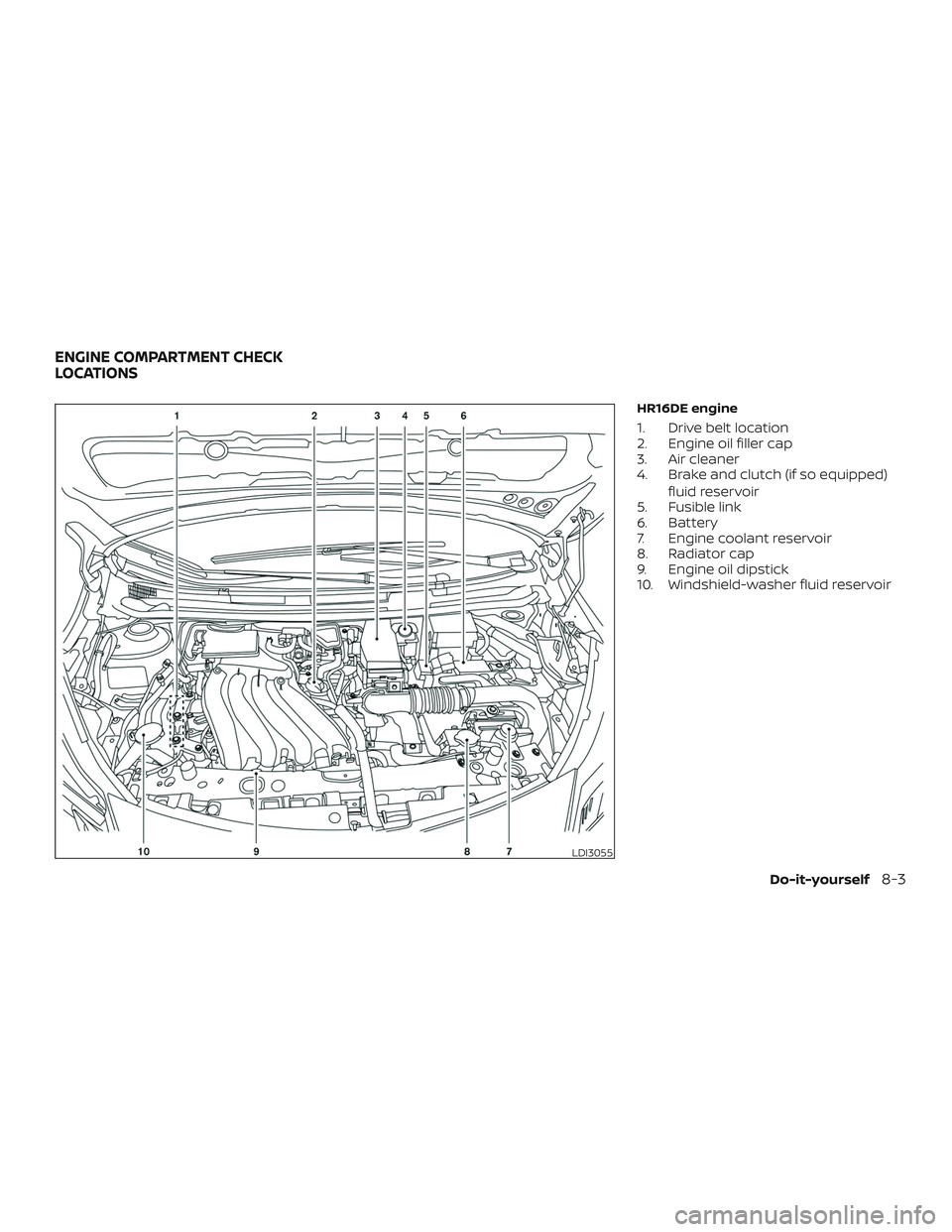
HR16DE engine
1. Drive belt location
2. Engine oil filler cap
3. Air cleaner
4. Brake and clutch (if so equipped)
fluid reservoir
5. Fusible link
6. Battery
7. Engine coolant reservoir
8. Radiator cap
9. Engine oil dipstick
10. Windshield-washer fluid reservoir
LDI3055
ENGINE COMPARTMENT CHECK
LOCATIONS
Do-it-yourself8-3